Abstract
Gamification is a prominent concept that has been in the spotlight over recent years, parallel to the advancement of technology. It integrates game attributes in a non-game setting to promote learners’ engagement during the process of learning. Educators are increasingly faced with imparting and fostering sustainable practices on topics pertaining to sustainability to primary school learners in Malaysia. Sustainability has become an essential topic in schools, usually embedded in stories and language teaching. Therefore, this paper aims to explain how features of gamification impact learners’ engagement and motivation in learning topics on sustainability. The theories of cognitive development were the basis of teaching to encourage cooperative play activity and incorporate into cognitive play activity that fosters pupils’ motivation and self-determination. This study applied a quantitative approach involving 33 primary school English teachers who were familiar with gamification and its implementation in education. The findings reflect its positive impact on learners’ process of acquiring knowledge as the majority of the respondents agreed that the presence of gamification in a lesson triggers learners’ curiosity. With its fun element, gamification can engage learners in sustainability issues, create a deeper understanding of the topic, and relate it directly to learners’ values and decision-making process.
Keywords: CEFR, Engagement, Game elements, Motivation, Sustainability
Introduction
Gamification is a concept widely accepted by many due to its ability to yield a positive teaching or learning outcome. According to Zimmerling et al. (2019), scientifically, gamification is defined as a condition where game elements are integrated into a non-game context, which in this case refers to an educational setting. Gamification also exists in both analogue and digital forms, allowing educators to adopt and adapt this concept based on their teaching agenda. Gamification is considered handy when delivering knowledge, as our current education does more than provide information to learners. The curriculum is refined to furnish the younger generation with the necessary skills to become active critical learners of the 21st century (Ratnaningsih, 2016).
Every learner is given the undivided attention and chance to prove that they can be a better version of themselves, regardless of gender and race. This is parallel to Goal 4 of the 2030 Agenda of Sustainable Development – Ensure inclusive and equitable quality education and promote lifelong learning opportunities for all (United Nations, 2015). It is an initiative taken by the United Nations to grant access to endless learning opportunities that can aid the children and youth in gaining knowledge and skills required to fit in the society. The responsibility was entrusted to UNESCO, the United Nations’ organisation for instructions, to guide the Agenda of Education 2030 that serves as a global enhancement plan to eliminate impoverishment based on the 17 Sustainable Development Goals by the year 2030 (Nazar et al., 2018).
Unfortunately, this intention is poorly recognized by the public. It is pivotal for it to be acknowledged to ensure its successful execution. Therefore, it is necessary to raise awareness regarding the concept of sustainability from a tender age to guarantee its application in our lives by introducing sustainability-related topics via gamification, making its recognition in education to young learners. Hence, teachers should then be permitted to improvise the educational setting with game elements to enhance learners’ participation (Mohamad et al., 2017). It is relatively similar to killing two birds with one stone because gamified learning promotes both fun learning and students’ involvement in the process of acquiring knowledge (Zakaria et al., 2018).
Literature Review
One will surely grasp knowledge if they display attentiveness to a particular tool, as discovered by previous studies (Hashim et al., 2019). This applies to the concept of gamification in a classroom where the game elements create an exciting learning experience for the students. According to Rafiq et al. (2019), there is a tendency for them to learn better in a fun setting which indirectly enables them to concentrate better. The positive influence of gamification has intrigued scholars to look into its mechanics to be utilised to develop teaching or learning materials (Kyewski & Kramer, 2018).
As stated by Ding (2019), the game mechanics, or better identified as game elements, plays the role of a catalyst to trigger students’ determination to learn in various ways, such as cooperating with or competing against their peers. Examples of common game elements used in an educational context are as displayed in Figure 1, which include point, badge, and leader board. It is deemed a win-win situation for both educators and learners to integrate these into lessons because it allows the teachers to introduce new content differently. In contrast, the students get to subconsciously gain new information as they have fun with their friends.
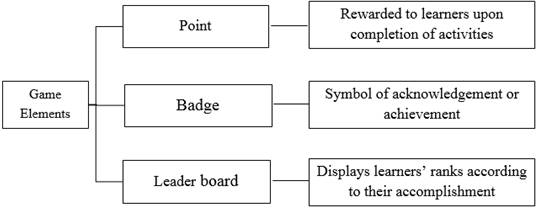
Teachers will also be able to provide an ideal student-centered environment by implementing gamification in the classroom. Huang and Soman (2013) proposed a guide to implementing gamification in lessons that depicts a step-by-step process, as displayed in Figure 2, to be pondered upon by the teachers, which would result in a successful execution of a gamified lesson.

Firstly, teachers must identify the target audience and their capabilities or level of proficiency to cater to their needs. Teachers must also set a goal to be accomplished by the end of the lesson, leading to the next step to break down the goal into more miniature stages. Hence, ensuring learners are able to achieve it gradually at a steady pace. The teaching aids will then have to be prepared according to their usage in a certain stage mentioned earlier to emphasise learners’ understanding. Lastly, teachers can apply suitable game elements in accordance with the activity prepared.
For instance, the Common European Framework of Reference for Languages (CEFR) syllabus for primary school introduces the topic of recycling in Module 7 of the textbook. It could be broken down into three parts: definition, purpose, and application. The teacher eventually determines the instructional design for the task set, such as a true or false quiz to test learners’ comprehension of the topic. The game element is later incorporated as a tool to support the task, i.e., points to be rewarded for every correct answer in the quiz and a leader board to rank the learners according to their accumulated points.
Methodology
This study applied the quantitative approach where a survey was conducted online via WhatsApp. The 33 respondents, primary school English language teachers who have had experience with gamification, were required to complete a questionnaire pertaining to the implementation of the concept to facilitate lessons on sustainability. The questionnaire was measured using a 5-point Likert scale ranging from 1 (totally disagree) to 5 (totally agree). The data was then derived and analysed to be presented via descriptive analysis. The mean scores, standard deviation, and percentages were shown to distinguish respondents’ answers to the questionnaire administered. Specific data was extracted from the table to be discussed further, and it was able to portray the effectiveness of a gamified lesson to introduce topics regarding sustainability.
Findings
The findings of this study were obtained and analysed to be presented visually through tables and graphs. Table 1 portrays the man and standard deviation to the English teachers’ response based on their view on the effectiveness of gamification in sustainability-related topics during their teaching process. In contrast, Figures 3 to 7 show the result in percentages.
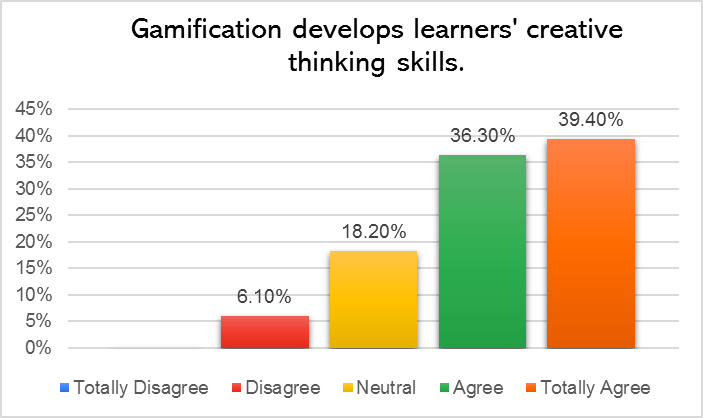
The descriptive statistics for ‘ depicts=4.09 (=0.914), to which no respondents totally disagreed, 6.1% disagreed, 18.2% were neutral, 36.3% agreed, and 39.4% totally agreed.
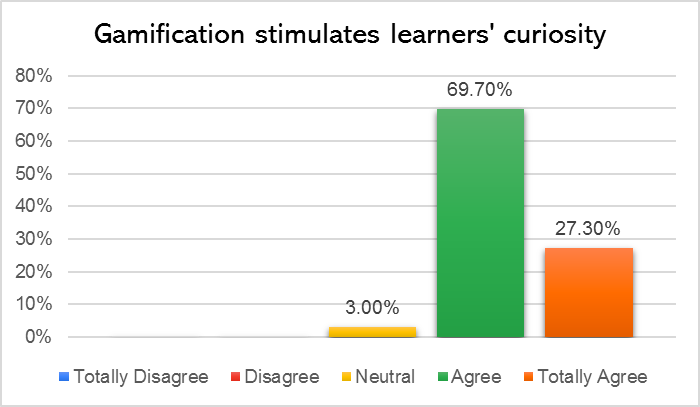
The descriptive statistics for ‘ revealed the highest mean with=4.24 (=0.502), showing a vast majority of teachers agreed with the statement. No respondents totally disagreed or disagreed with the statement, while 3% were neutral, 69.7% agreed, and 27.3% totally agreed.
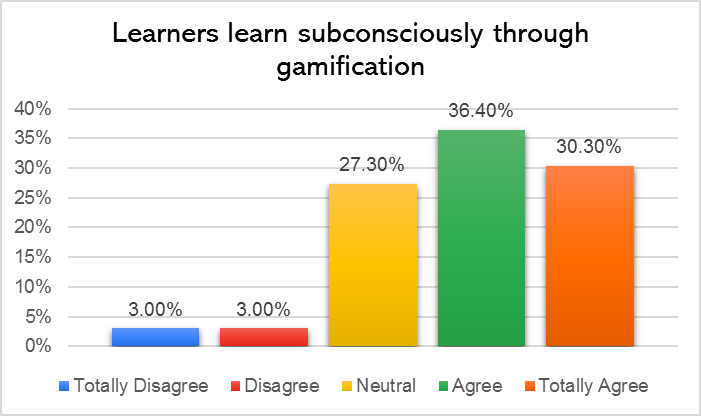
As for ‘,=3.88 (=0.992) was shown. To this statement, 3% of the respondents totally disagreed, 3% disagreed, 27.3% were neutral, 36.4% agreed, and 30.3% totally agreed.
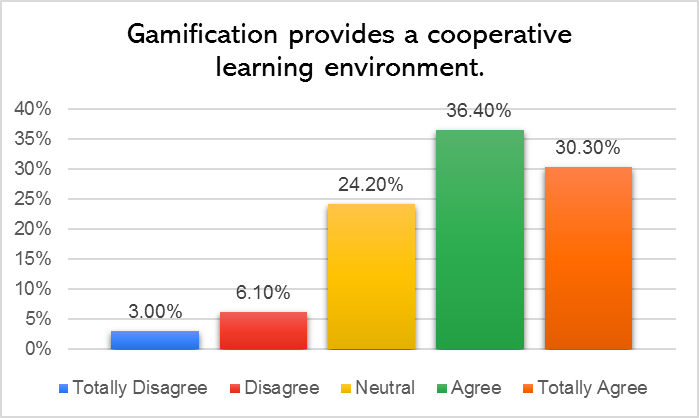
On the other hand, the descriptive statistics for ‘ portrays=3.85 (=1.034). 3% of the respondents totally disagreed, whereas 6.1% disagreed, 24.2% were neutral, 36.4% agreed, and 30.3% totally agreed to the statement.
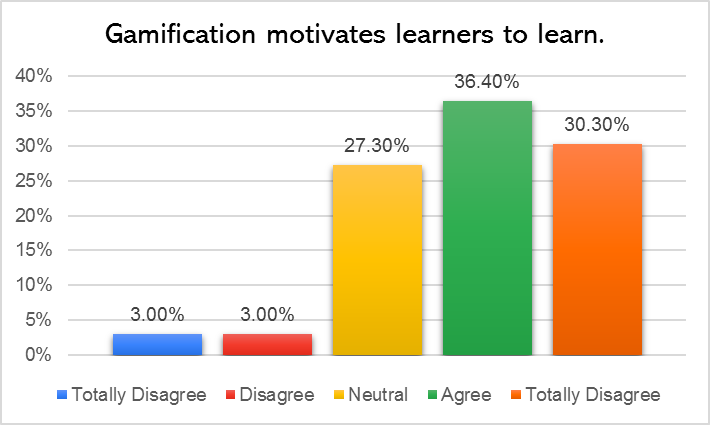
Lastly, ‘ indicated=3.88 (=0.992). 3% out of the total number of respondents totally disagreed and disagreed, while 27.3% were neutral, 36.4% agreed, and 30.3% claimed to be totally agreed.
Discussion
Sustainability is an essential topic to be taught in schools as it highlights the environment as a significant example to create awareness among learners. A portion of the data collected from the survey depicts the various ways gamification has been known to influence learners positively on the topic of sustainability. The results show gamification affects learners positively in their learning progress, boosting their motivation and promoting their involvement in the classroom (Buckley & Doyle, 2016; Papp, 2017). The highest mean score for shows that the statement is agreed by most of the respondents who participated in this study. A change in the setting draws attention to the lesson, which represents the potential to educate and encourage learners on sustainable practices. As the respondents of this study agree, gamification is also believed to provide a cooperative learning environment where learners interact with their peers and develop their thinking skills. Therefore, this has indirectly boosted their motivation and enabled them to have fun as they learn (Davis et al., 2018).
Conclusion
Educators around the globe widely accept gamification to ensure their learners can acquire new knowledge in a carefree manner without burdening them with academic pressure. It is also known to motivate learners to learn better, resulting in a positive yield (White & McCoy, 2019). Therefore, this concept is deemed to be an effective approach if it is implemented with the intention to introduce and enhance learners’ comprehension of an underrated topic, i.e., sustainability, especially when it concerns the well-being of our younger generation in the future.
Acknowledgments
We would like to thank the Malaysian Ministry of Higher Education for funding this study under Fundamental Research Grant Scheme (FRGS Nos. FRGS/1/2019/SSI09/UNISEL/03/3). This work was supported by Universiti Selangor (UNISEL).
References
Buckley, P., & Doyle, E. (2016). Gamification and student motivation. Interactive Learning Environments, 24(6), 1162-1175. DOI:
Davis, K., Sridharan, H., Koepke, L., Singh, S., & Boiko, R. (2018). Learning and engagement in a gamified course: Investigating the effects of student characteristics. Journal of Computer Assisted Learning, 34(5), 492-503. DOI:
Ding, L. (2019). Applying gamifications to asynchronous online discussions: A mixed methods study. Computers in Human Behavior, 91, 1-11. DOI:
Hashim, H., Rafiq, K. R. M., & Yunus, M. M. (2019). Improving ESL Learners’ Grammar with Gamified-Learning. Arab World English Journal (AWEJ), Special Issue (5), 41-50. DOI:
Huang, W. H.-Y., & Soman, D. (2013). A practitioner’s guide to gamification of education. University of Toronto, Rotman School of Management.
Kyewski, E., & Kramer, N. C. (2018). To gamify or not to gamify? An experimental field study of the influence of badges on motivation, activity, and performance in an online learning course. Computers & Education, 118, 25-37. DOI:
Mohamad, S. N. M., Sazilah, S., & Bakar, N. (2017). An analysis of gamification elements in online learning to enhance learning engagement. In Zulikha, J., & N. H. Zakaria (Eds.), Proceedings of the 6th International Conference on Computing & Informatics, 452-460. Sintok: School of Computing. https://www.academia.edu/35838427/AN_ANALYSIS_OF_GAMIFICATION_ELEMENTS_IN_ONLINE_LEARNING_TO_ENHANCE_LEARNING_ENGAGEMENT
Nazar, R., Chaudhry, I. S., Ali, S., & Faheem, M. (2018). Role of Quality Education for Sustainable Development Goals (SDGS). PEOPLE: International Journal of Social Sciences, 4(2), 486-501. DOI:
Papp, A. T. (2017). Gamification Effects on Motivation and Learning: Application to Primary and College Students. International Journal for Cross-Disciplinary Subjects in Education (IJCDSE), 8(3), 3193-3201. DOI:
Rafiq, K. R. M., Pazilah, F. N., Yunus, M. M., Hashim, H. (2019). Gamified-Learning Brings Out the Hero in You! International Invention, Innovative & Creative (InIIC) Conference, 67-71. MNNF Publisher.
Ratnaningsih. S. (2016). Character Education in Primary School Students Prepare to Face Challenges of the 21st Century. Proceedings of the International Conference on Ethics in Governance (ICONEG 2016), 48-53. Atlantis Press. DOI:
United Nations (2015). Transforming our world: 2030 agenda for sustainable development. United Nations.
White, K., & McCoy, L. P. (2019). Effects of Game-Based Learning on Attitude and Achievement in Elementary Mathematics. Networks: An Online Journal for Teacher Research, 21(1). DOI:
Zakaria, N. Y. K., Zaini, H., Hamdan, F., & Norman, H. (2018). Mobile Game-based Learning for Online Assessment in Collaborative Learning. International Journal of Engineering and Technology, 7(4), 80-85. https://www.researchgate.net/publication/329829428
Zimmerling, E., Höllig, C. E., Sandner, P. G., & Welpe, I. M. (2019). Exploring the influence of common game elements on ideation output and motivation. Journal of Business Research, 94, 302-312. DOI:
Copyright information

This work is licensed under a Creative Commons Attribution-NonCommercial-NoDerivatives 4.0 International License.
About this article
Publication Date
31 October 2022
Article Doi
eBook ISBN
978-1-80296-958-0
Publisher
European Publisher
Volume
3
Print ISBN (optional)
-
Edition Number
1st Edition
Pages
1-802
Subjects
Multidisciplinary sciences, sustainable development goals (SDG), urbanisation
Cite this article as:
Rao, Y. S., Mee Mee, R. W., Abd Ghani, K., Pek, L. S., Von, W. Y., Ismail, M. R., & Tengku Shahdan, T. S. (2022). Gamification In Education For Sustainable Development. In H. H. Kamaruddin, T. D. N. M. Kamaruddin, T. D. N. S. Yaacob, M. A. M. Kamal, & K. F. Ne'matullah (Eds.), Reimagining Resilient Sustainability: An Integrated Effort in Research, Practices & Education, vol 3. European Proceedings of Multidisciplinary Sciences (pp. 155-162). European Publisher. https://doi.org/10.15405/epms.2022.10.15

